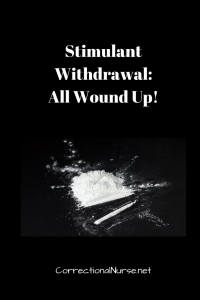Primary concerns in substance withdrawal are alcohol and opiates, and rightly so. Withdrawal of these two drugs of abuse can cause serious health concern. Stimulants such as cocaine, methamphetamine, crack, and amphetamines are also popular among the inmate patient population and can cause significant effects when abruptly withdrawn upon incarceration. Fortunately, stimulant withdrawal, while uncomfortable, is rarely life-threatening.
A Case of the Jitters
Stimulant intoxication may well be the initiating circumstance landing your patient in booking. Cocaine and meth are used for a heightened sense of well-being and euphoria. However, they can also lead to aggressive and violent behaviors. Here is a list of common negative effects of stimulant over-use:
- Emotional instability
- Agitation, restlessness, irritability
- Impaired judgment
- Poor impulse control
- Aggression
Charges for domestic violence, aggressive driving, or property destruction may result when things get out of hand. Besides the above behavioral observations, other signs of stimulant intoxication that might be noted on booking include:
- Rapid heart rate
- Elevated blood pressure
- Dilated pupils
- Increased temperature
If a patient presents with these indications of stimulant over-use, probe further into their drug-taking behaviors and usual withdrawal symptoms. This information will help in developing a plan to manage their withdrawal while incarcerated.
Stimulant Withdrawal Effects
Coming off stimulant use results in irritating then depressing the nervous system. The patient can expect to first experience agitation, intense drug cravings, and insomnia. Farther into withdrawal this changes to lethargy, fatigue, and dulled senses causing excessive sleepiness.
Stimulant Withdrawal Management
Stimulant withdrawal usually doesn’t require medical management and protocols rarely include medications, but they do require monitoring. For example, the Federal Bureau of Prisons Withdrawal Protocols recommends symptom management only. However, cardiac complications can be seen, especially in compromised individuals like the elderly or those with cardiac or respiratory disease. A baseline EKG and follow-up may be warranted.
Stimulant withdrawal behind bars is basically a self-managed event requiring the inmate to initiate health care contact for symptom relief. Therefore, it is important to provide instruction on how to access the medical unit and when to seek out treatment. Explore ways the person has managed periods without the drug in the past and provide options within available processes during incarceration.
Stimulant Withdrawal and Self-harm
Although stimulant withdrawal may not be life-threatening, coming down off uppers can lead to severe depression and suicide ideation. This ‘crash’ may happen quickly with rapidly metabolizing drugs like cocaine or more slowly with longer-acting stimulants like methamphetamine. The conclusion of withdrawal symptoms follows the same progression with acute cocaine withdrawal lasting from 3-4 days while methamphetamine can last 1-2 weeks. Unfortunately, drug craving can last much, much longer.
Engage available mental health treatment for this patient. Suicide evaluation, drug treatment programs, and group therapy are all beneficial.
Mixed Withdrawal Alert
Like so many of our patients, stimulant users will self-medicate with other substances to smooth out uncomfortable symptoms of their drug of choice. So, be aware that cocaine and methamphetamine users are likely to also use alcohol, benzodiazepines, or opiates to mellow out between fixes or after binges. Specifically ask about what your patient uses to even out their stimulant highs and be prepared to manage possible withdrawal from these substances, as well.
Are stimulants like cocaine, methamphetamine, crack, or amphetamines popular with your patient population? Share your withdrawal tips in the comments section of this post.
[This information was originally posted on the Essentials of Correctional Nursing blog]

Julia Worrall says
Excellent article!